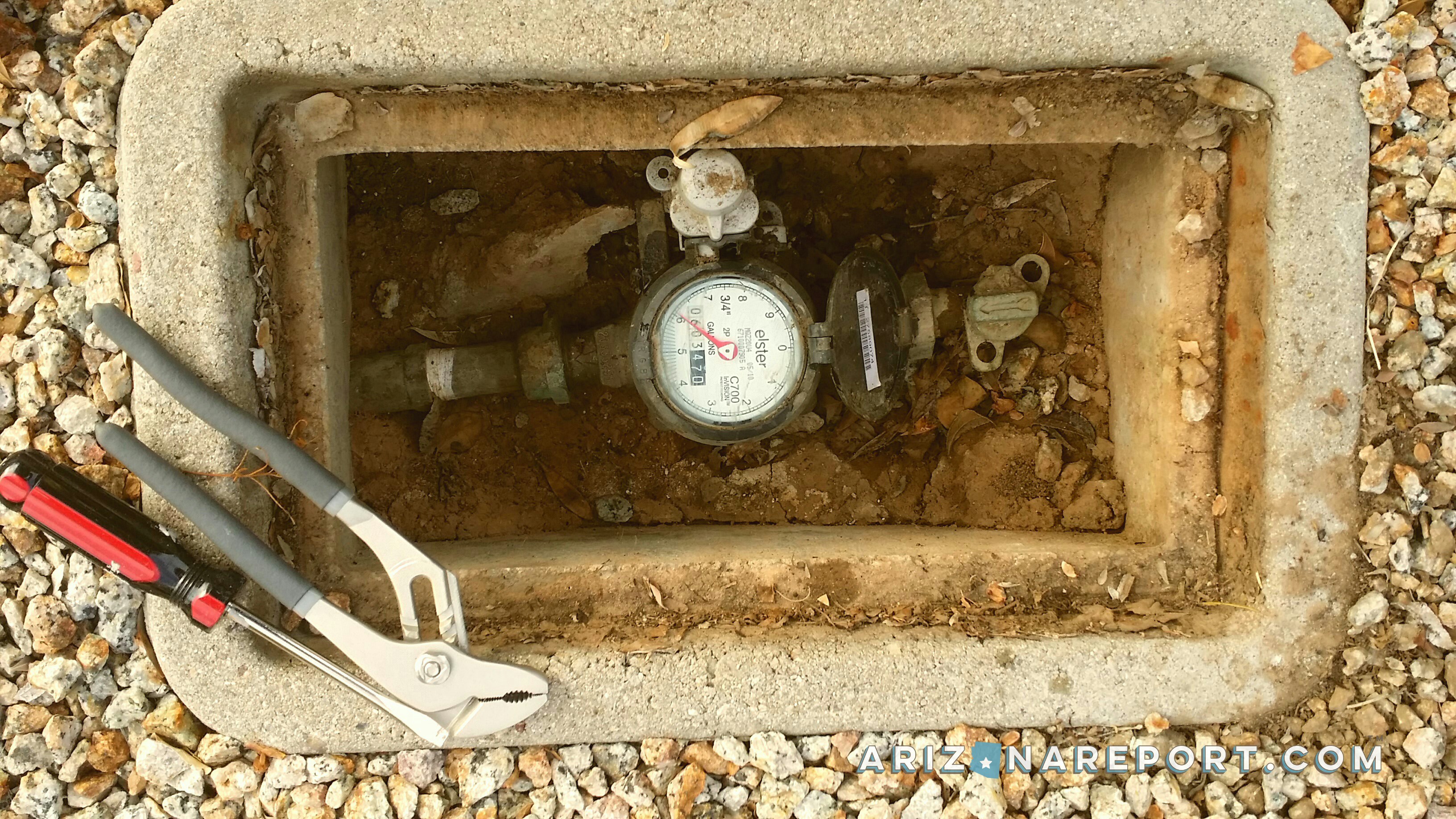- Fountain Hills Ties as Safest Zip Code in Phoenix - Oct 14, 2019
- How Many Single-Family Homes in Maricopa County? - Oct 13, 2019
- Investing in Multi-Family Real Estate in Your 20s - Oct 9, 2019
A high monthly water bill can get your attention quickly. If the increase can’t easily be reconciled by inflated use or hotter weather demand from a pool or evaporative cooler, it’s time to investigate.
If a visual inspection around your home is inconclusive, you will need to begin to isolate a suspected leak from its source. Here are the steps that I take when attempting to locate a residential water leak.
Taking it to the street
For residents with city water service, the first stop is the water meter pit. This is the most definitive source for clues about a water leak in your home. Most water meter pits are located in the front yard within a few feet of the sidewalk or curb.
If the cast iron meter pit cover is not readily visible, it could be buried a few inches under landscaping gravel. To locate the pit, follow your main water shut off valve near the house and sight a line directly to the street. You could also look across the street at the neighbor’s meter pit cover to generally determine where yours might be located in a corresponding spot in your yard.
Before opening the water meter pit cover, you will need a few tools. I like to use a pair of channel-locks and a flat-head screwdriver (pictured above). Open the lid carefully. These shallow covered holes can be popular condos for scorpions, bees, and rattlesnakes. Once opened, pull back the plastic cover on the face of the meter.
What to look for
The meter in the photo above is an analog dial meter. Yours may be digital with a solar-powered LCD display. (If a digital meter in hard to read in dim light, use a flashlight to power the LCD meter screen).
Turn off all water sources around the home. Monitor the meter dial for the slightest movement.
Most analog water meters have a low-flow-indicator on the dial face. This appears as a spinning red or white triangle, silver gear or black star. Its purpose is to display minuscule water flow amounts that would not be immediately detectable on the meter dial. Any visual rotation in the low-flow-indicator means that water is moving through the meter. Water meters offer readings in gallons or cubic feet of water.
Next, close the main water shut-off valve at the side of the house. If the meter dial continues to spin, the leak is in the underground front yard water service line. If the meter stops spinning after the main shut water shut-off valve is closed, the leak is in the house, pool or irrigation system.
Check the usual suspects
First, observe the toilet bowls for phantom flushes. Toilets are common leak culprits accounting for 20% to 35% of residential water leaks. They are easily diagnosed and repaired. Phantom flushes are slow leaks visible as trickling water at the rear interior of the toilet bowl. Most often they are accompanied by a barely-audible running water sound or hissing noise from the fill valve inside the tank.
Phantom flushes are addressed by replacing the seal on the flapper inside the toilet tank. These seals degrade over time and allow water to leak into the bowl. They may seem insignificant, but a phantom flush can waste thousands of gallons of water a year.
The number two likely offender is the swimming pool. It is estimated that 1 in 20 pools has some type of leak. Automatic pool filler valves are convenient, but if the valve jams in the open position, thousands of gallons of water could flow before the homeowner is alerted. This happened to a close friend of mine. He was 1,800 miles away from his Arizona home. Neighbors called to say that water was flowing into the street from his backyard pool.
Additionally, pool walls can develop hairline cracks causing an insatiable demand for water from the automatic filler valve.
Some areas in Arizona are known for expansive soils. Communities like Anthem, Tolleson, Gilbert and Mesa are susceptible to the shrink-swell cycles of clay soil after heavy rains. This can be problematic for underground pipes around pools. Check the ground around the pool deck and equipment pad for wet areas that would indicate an underground PVC pipe rupture.
The leak investigation lineup also includes the water heater. You may not see any leaking water around the base. However, water heaters can spring leaks from a hidden location and there may never be any evidence on the floor. For example, each tank has a temperature-pressure-release valve (TPR valve) located near the top. These open on their own if the pressure inside the tank exceeds limits for safety. Older TPR valves can corrode and leak. TPR valves are plumbed to take discharged scalding water away from the water heater. A leak in a TPR valve would only be visible near the termination of the drain line.
In the arid Sonoran Desert, rooftop evaporative coolers (swamp coolers) are a popular alternative to central air conditioning. These are especially common on older mid-century homes around Phoenix. The city water service in the home supplies water to the cooling pads on the roof unit. Outside air is pulled through the pads, cooled by dripping water. Air is then circulated through the home. A refill valve on a swamp cooler can stick open and demand continuous flow. However, because excess water drains away through a pipe to the sewer or side yard, a homeowner would not see any visible signs from inside the home.
Other sources of hidden household water leaks
- sub-slab water supply pipes
- lawn sprinkler heads
- irrigation drip lines
- hose spigots
- water fountain pumps and cracked liners
- pool pump PVC lines and multi-port valves
- water softener valves and discharge lines
Underground leak events
One notable sub-slab leak anecdote in Phoenix occurred in the Anthem development in the north Valley.
During new home construction here in the early 2000s, hot water supply pipes were buried in tandem with cold water lines under the foundation. Pipes rested in mildly corrosive soil without appropriate protector sleeves. After a few years, thermal galvanic corrosion (TGC) resulted in weakened copper pipes and several hot water lines developed leaks. A class action lawsuit resulted. Only a portion of homes in Anthem became affected. More information can be found at www.anthempipes.com.
Know your pipes
Always be aware of the location of the main water shut-off valve in your home. Keep access to it clear and unobstructed. In the event of an abrupt and catastrophic leak, this will be the first place to take action. If you are unsure, consult a plumber or handyman.
Investigate promptly if you suspect that you have a water leak. A single faucet dripping just once every 2 seconds will waste more than 1,000 gallons of water annually.
Acting is not an important job in the scheme of things. Plumbing is.
– Spencer Tracy, American silver screen star and winner of two Academy Awards for Best Actor







